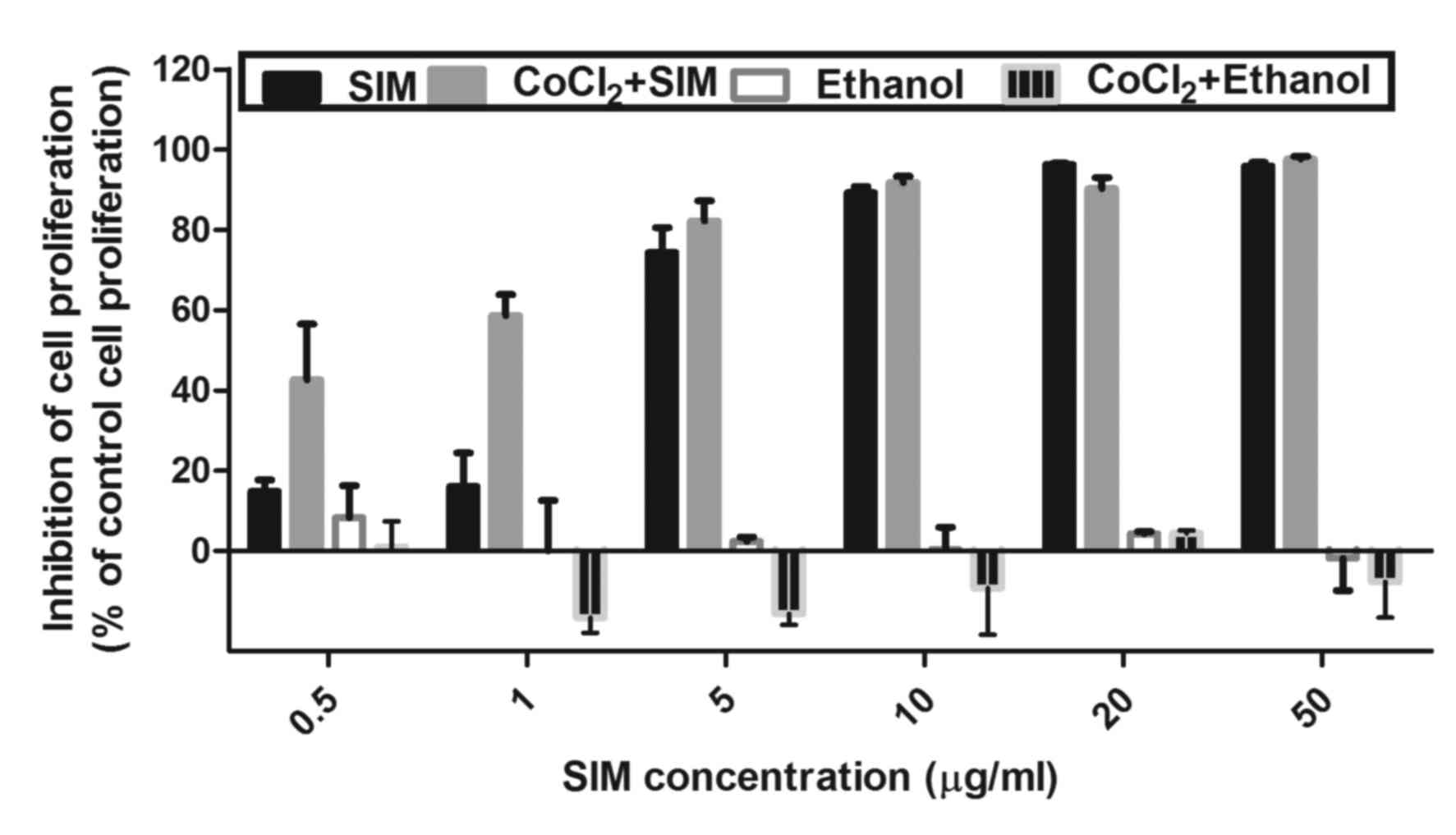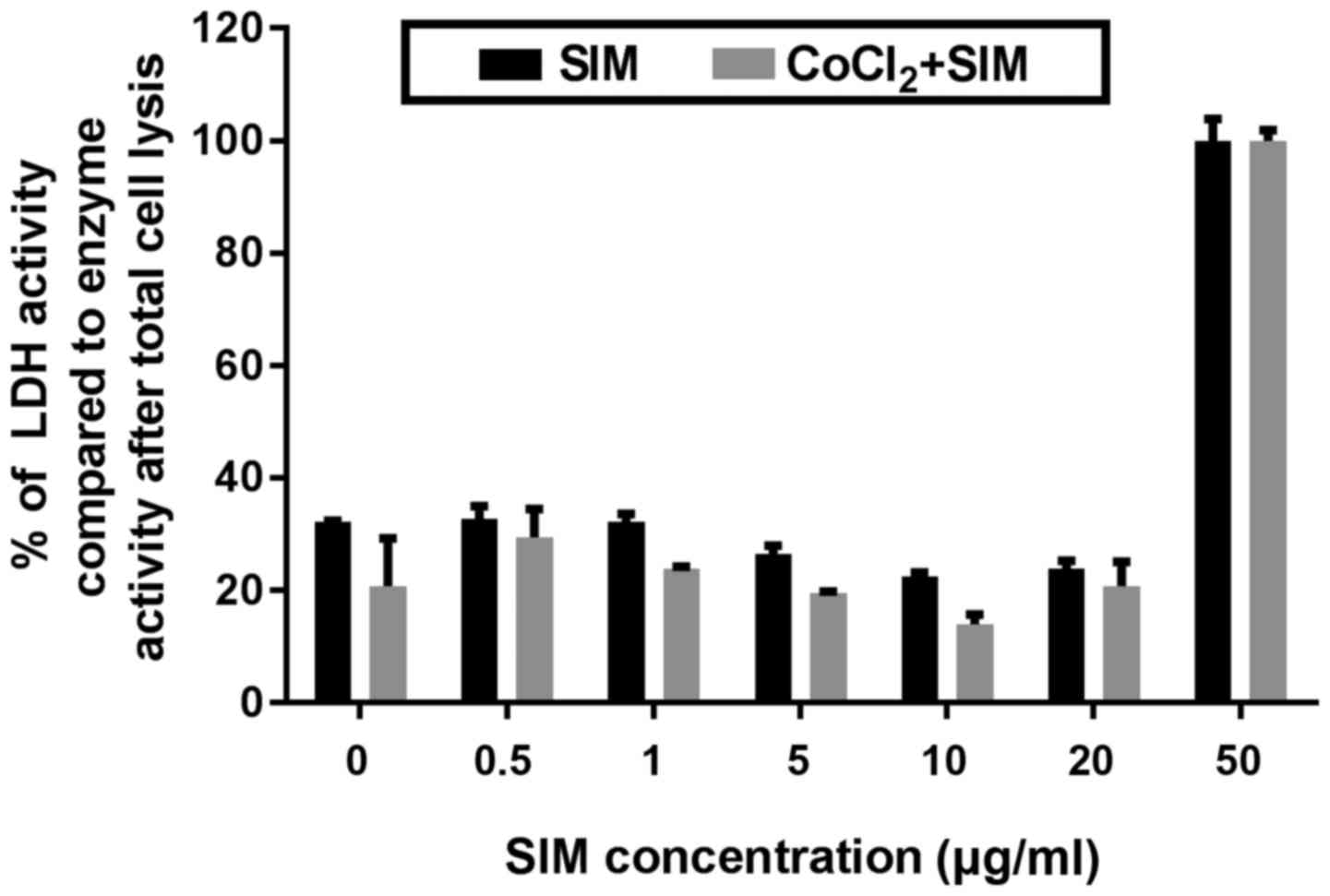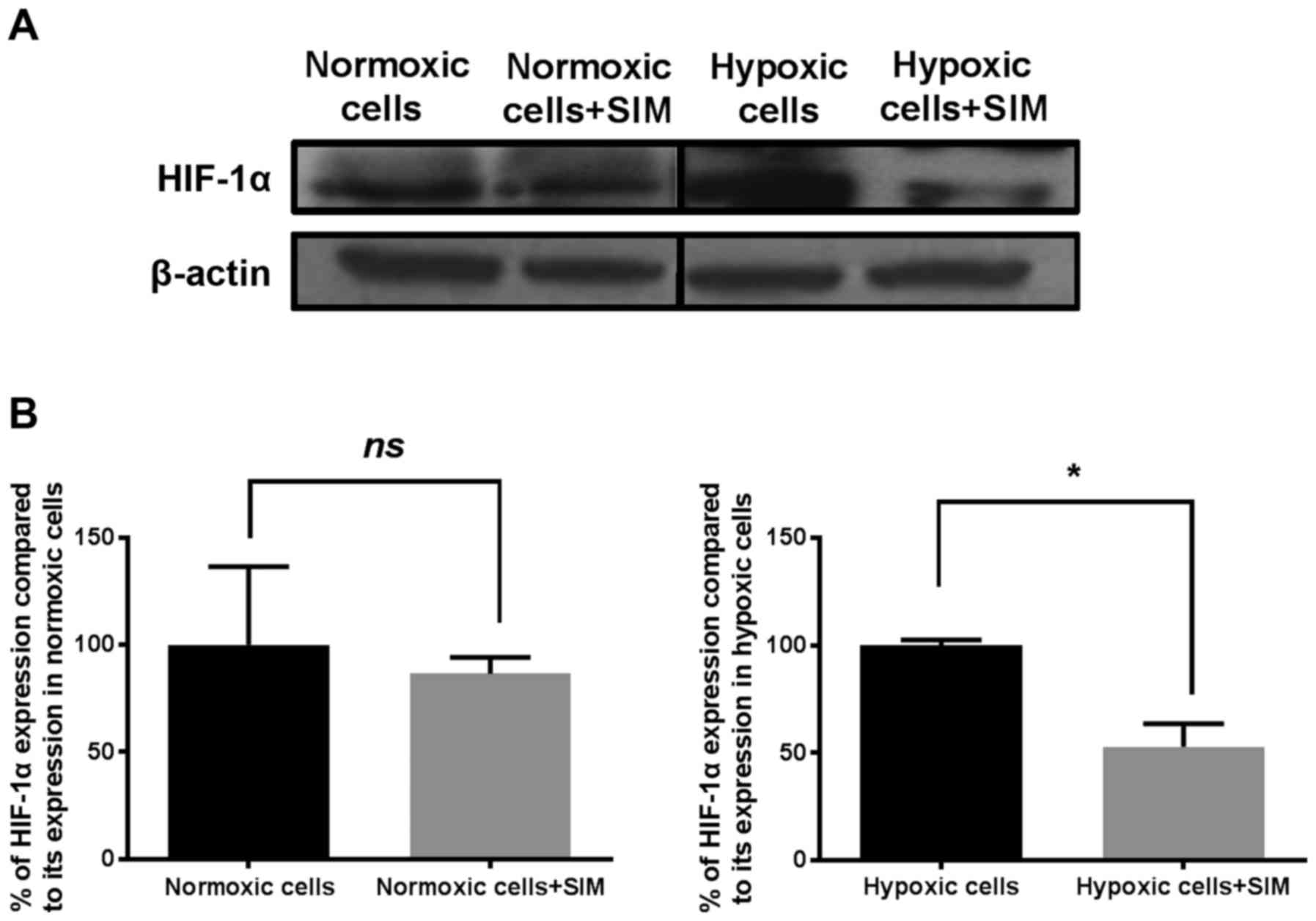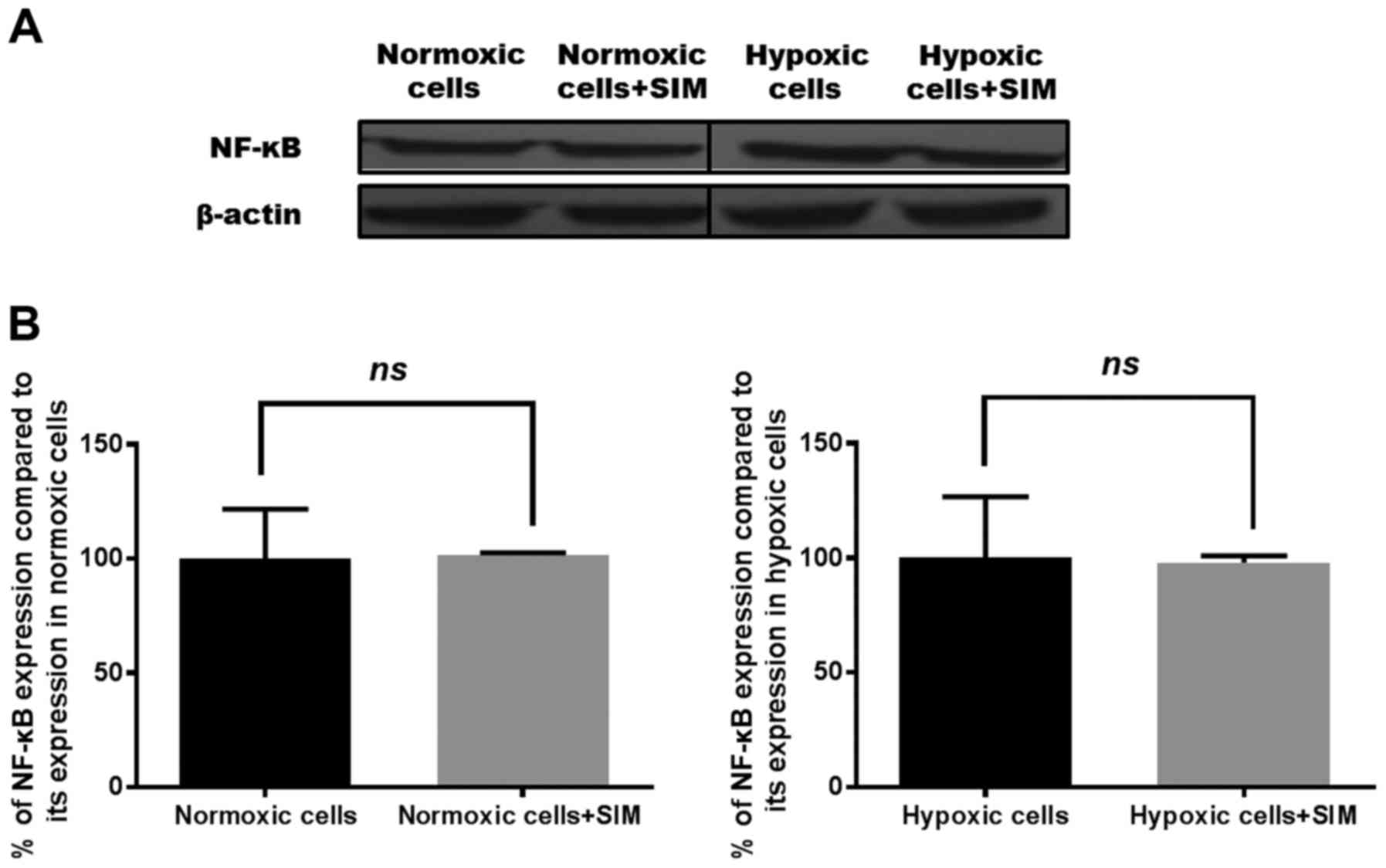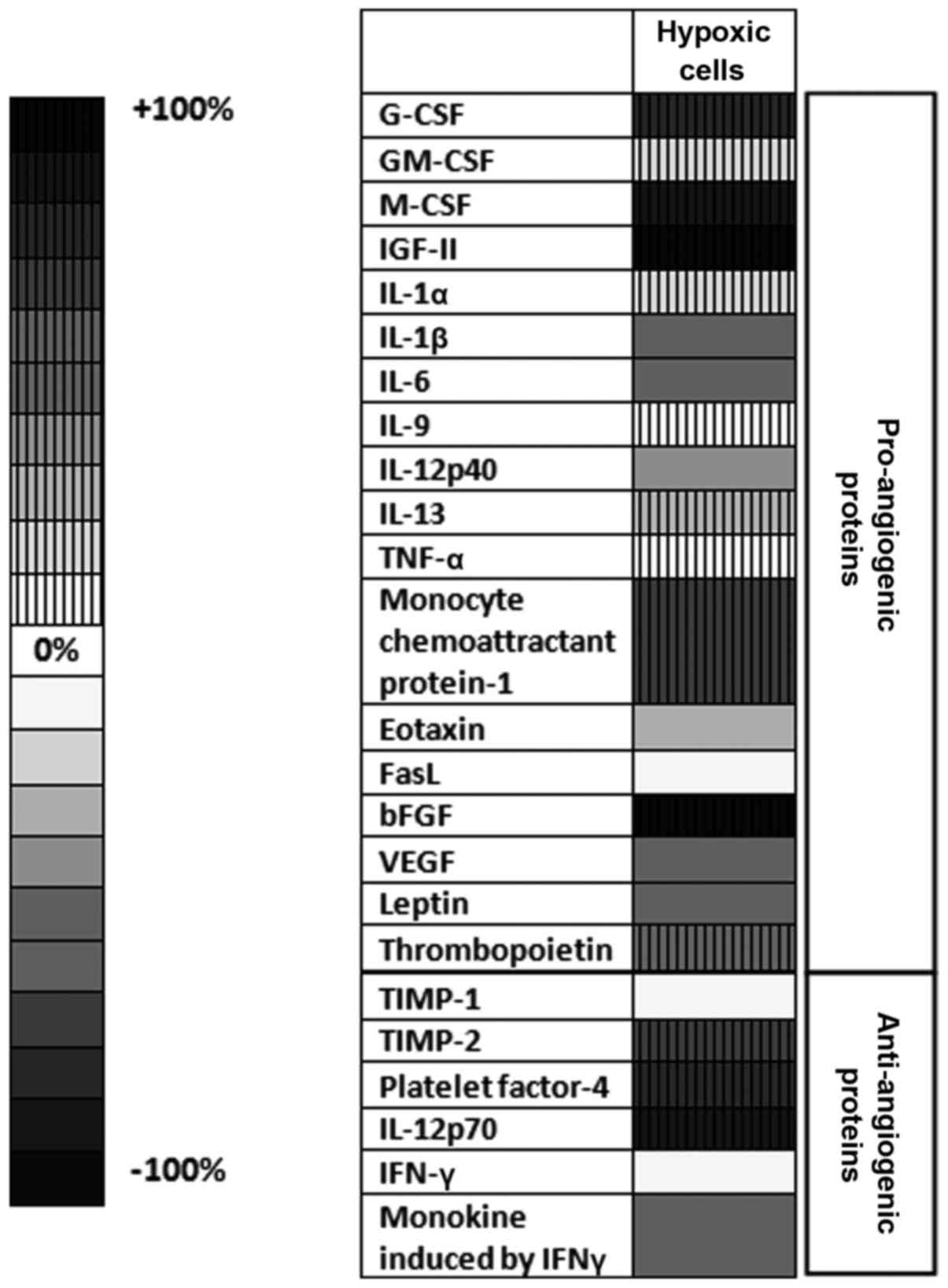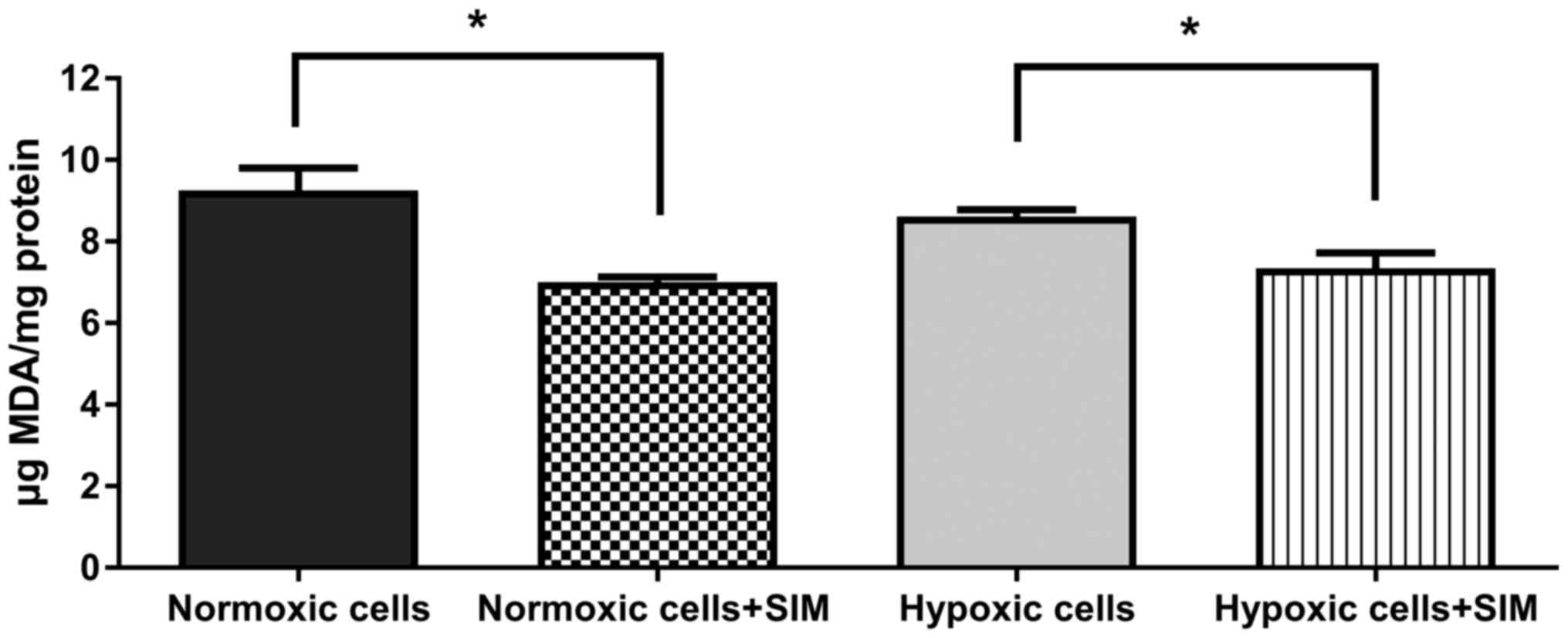|
1
|
Alupei MC, Licarete E, Cristian FB and
Banciu M: Cytotoxicity of lipophilic statins depends on their
combined actions on HIF-1α expression and redox status in B16.F10
melanoma cells. Anticancer Drugs. 25:393–405. 2014. View Article : Google Scholar : PubMed/NCBI
|
|
2
|
Mills CN, Joshi SS and Niles RM:
Expression and function of hypoxia inducible factor-1 alpha in
human melanoma under non-hypoxic conditions. Mol Cancer. 8:1042009.
View Article : Google Scholar : PubMed/NCBI
|
|
3
|
Yajima I, Kumasaka MY, Thang ND, Goto Y,
Takeda K, Yamanoshita O, Iida M, Ohgami N, Tamura H, Kawamoto Y and
Kato M: RAS/RAF/MEK/ERK and PI3K/PTEN/AKT signaling in malignant
melanoma progression and therapy. Dermatol Res Pract.
2012:3541912012.PubMed/NCBI
|
|
4
|
Kuphal S, Winklmeier A, Warnecke C and
Bosserhoff AK: Constitutive HIF-1 activity in malignant melanoma.
Eur J Cancer. 46:1159–1169. 2010. View Article : Google Scholar : PubMed/NCBI
|
|
5
|
Masson N and Ratcliffe PJ: Hypoxia
signaling pathways in cancer metabolism: The importance of
co-selecting interconnected physiological pathways. Cancer Metab.
2:32014. View Article : Google Scholar : PubMed/NCBI
|
|
6
|
Kallio PJ, Wilson WJ, O'Brien S, Makino Y
and Poellinger L: Regulation of the hypoxia-inducible transcription
factor 1alpha by the ubiquitin-proteasome pathway. J Biol Chem.
274:6519–6525. 1999. View Article : Google Scholar : PubMed/NCBI
|
|
7
|
Kaelin WG Jr and Ratcliffe PJ: Oxygen
sensing by metazoans: The central role of the HIF hydroxylase
pathway. Mol Cell. 30:393–402. 2008. View Article : Google Scholar : PubMed/NCBI
|
|
8
|
Semenza GL: Hypoxia-inducible factor 1 and
cancer pathogenesis. IUBMB Life. 60:591–597. 2008. View Article : Google Scholar : PubMed/NCBI
|
|
9
|
Widmer DS, Hoek KS, Cheng PF, Eichhoff OM,
Biedermann T, Raaijmakers MI, Hemmi S, Dummer R and Levesque MP:
Hypoxia contributes to melanoma heterogeneity by triggering
HIF1α-dependent phenotype switching. J Invest Dermatol.
133:2436–2443. 2013. View Article : Google Scholar : PubMed/NCBI
|
|
10
|
Rodrigues M, Xin X, Jee K,
Babapoor-Farrokhran S, Kashiwabuchi F, Ma T, Bhutto I, Hassan SJ,
Daoud Y, Baranano D, et al: VEGF secreted by hypoxic Müller cells
induces MMP-2 expression and activity in endothelial cells to
promote retinal neovascularization in proliferative diabetic
retinopathy. Diabetes. 62:3863–3873. 2013. View Article : Google Scholar : PubMed/NCBI
|
|
11
|
Krock BL, Skuli N and Simon MC:
Hypoxia-induced angiogenesis: Good and evil. Genes Cancer.
2:1117–1133. 2011. View Article : Google Scholar : PubMed/NCBI
|
|
12
|
Ling FC, Khochfar J, Baldus SE, Brabender
J, Drebber U, Bollschweiler E, Hoelscher AH and Schneider PM:
HIF-1alpha protein expression is associated with the environmental
inflammatory reaction in Barrett's metaplasia. Dis Esophagus.
22:694–699. 2009. View Article : Google Scholar : PubMed/NCBI
|
|
13
|
Nakayama K: cAMP-response element-binding
protein (CREB) and NF-κB transcription factors are activated during
prolonged hypoxia and cooperatively regulate the induction of
matrix metalloproteinase MMP1. J Biol Chem. 288:22584–22595. 2013.
View Article : Google Scholar : PubMed/NCBI
|
|
14
|
van Uden P, Kenneth NS and Rocha S:
Regulation of hypoxia-inducible factor-1alpha by NF-kappaB. Biochem
J. 412:477–484. 2008. View Article : Google Scholar : PubMed/NCBI
|
|
15
|
Culver C, Sundqvist A, Mudie S, Melvin A,
Xirodimas D and Rocha S: Mechanism of hypoxia-induced NF-kappaB.
Mol Cell Biol. 30:4901–4921. 2010. View Article : Google Scholar : PubMed/NCBI
|
|
16
|
Gratzner HG: Monoclonal antibody to
5-bromo- and 5-iododeoxyuridine: A new reagent for detection of DNA
replication. Science. 218:474–475. 1982. View Article : Google Scholar : PubMed/NCBI
|
|
17
|
Coimbra M, Banciu M, Fens MH, de Smet L,
Cabaj M, Metselaar JM, Storm G and Schiffelers RM: Liposomal
pravastatin inhibits tumor growth by targeting cancer-related
inflammation. J Control Release. 148:303–310. 2010. View Article : Google Scholar : PubMed/NCBI
|
|
18
|
Singer CA, Figueroa-Masot XA, Batchelor RH
and Dorsa DM: The mitogen-activated protein kinase pathway mediates
estrogen neuroprotection after glutamate toxicity in primary
cortical neurons. J Neurosci. 19:2455–2463. 1999.PubMed/NCBI
|
|
19
|
Yang L, Xiao M, Li X, Tang Y and Wang YL:
Arginine ADP-ribosyltransferase 1 promotes angiogenesis in
colorectal cancer via the PI3K/Akt pathway. Int J Mol Med.
37:734–742. 2016.PubMed/NCBI
|
|
20
|
Kim J, Shao Y, Kim SY, Kim S, Song HK,
Jeon JH, Suh HW, Chung JW, Yoon SR, Kim YS and Choi I:
Hypoxia-induced IL-18 increases hypoxia-inducible factor-1alpha
expression through a Rac1-dependent NF-kappaB pathway. Mol Biol
Cell. 19:433–444. 2008. View Article : Google Scholar : PubMed/NCBI
|
|
21
|
Shi Y, Chang M, Wang F, Ouyang X, Jia Y
and Du H: Role and mechanism of hypoxia-inducible factor-1 in cell
growth and apoptosis of breast cancer cell line MDA-MB-231. Oncol
Lett. 1:657–662. 2010. View Article : Google Scholar : PubMed/NCBI
|
|
22
|
Banciu M, Schiffelers RM, Fens MH,
Metselaar JM and Storm G: Anti-angiogenic effects of liposomal
prednisolone phosphate on B16 melanoma in mice. J Control Release.
113:1–8. 2006. View Article : Google Scholar : PubMed/NCBI
|
|
23
|
Del Rio D, Stewart AJ and Pellegrini N: A
review of recent studies on malondialdehyde as toxic molecule and
biological marker of oxidative stress. Nutr Metab Cardiovasc Dis.
15:316–328. 2005. View Article : Google Scholar : PubMed/NCBI
|
|
24
|
Karatas F, Karatepe M and Baysar A:
Determination of free malondialdehyde in human serum by
high-performance liquid chromatography. Anal Biochem. 311:76–79.
2002. View Article : Google Scholar : PubMed/NCBI
|
|
25
|
Culver C, Sundqvist A, Mudie S, Melvin A,
Xirodimas D and Rocha S: Mechanism of hypoxia-induced NF-kappaB.
Mol Cell Biol. 30:4901–4921. 2010. View Article : Google Scholar : PubMed/NCBI
|
|
26
|
Nakayama K: cAMP-response element-binding
protein (CREB) and NF-κB transcription factors are activated during
prolonged hypoxia and cooperatively regulate the induction of
matrix metalloproteinase MMP1. J Biol Chem. 288:22584–22595. 2013.
View Article : Google Scholar : PubMed/NCBI
|
|
27
|
Vaupel P, Mayer A and Höckel M: Tumor
hypoxia and malignant progression. Methods Enzymol. 381:335–354.
2004. View Article : Google Scholar : PubMed/NCBI
|
|
28
|
Semenza GL: HIF-1, O(2) and the 3 PHDs:
How animal cells signal hypoxia to the nucleus. Cell. 107:1–3.
2001. View Article : Google Scholar : PubMed/NCBI
|
|
29
|
Semenza GL: Defining the role of
hypoxia-inducible factor 1 in cancer biology and therapeutics.
Oncogene. 29:625–634. 2010. View Article : Google Scholar : PubMed/NCBI
|
|
30
|
Glynn SA, O'Sullivan D, Eustace AJ, Clynes
M and O'Donovan N: The 3-hydroxy-3-methylglutaryl-coenzyme A
reductase inhibitors, simvastatin, lovastatin and mevastatin
inhibit proliferation and invasion of melanoma cells. BMC cancer.
8:92008. View Article : Google Scholar : PubMed/NCBI
|
|
31
|
Rius J, Guma M, Schachtrup C, Akassoglou
K, Zinkernagel AS, Nizet V, Johnson RS, Haddad GG and Karin M:
NF-kappaB links innate immunity to the hypoxic response through
transcriptional regulation of HIF-1alpha. Nature. 453:807–811.
2008. View Article : Google Scholar : PubMed/NCBI
|
|
32
|
Krock BL, Skuli N and Simon MC:
Hypoxia-induced angiogenesis: Good and evil. Genes Cancer.
2:1117–1133. 2011. View Article : Google Scholar : PubMed/NCBI
|
|
33
|
Kerbel RS: Tumor angiogenesis: Past,
present and the near future. Carcinogenesis. 21:505–515. 2000.
View Article : Google Scholar : PubMed/NCBI
|
|
34
|
Lieu C, Heymach J, Overman M, Tran H and
Kopetz S: Beyond VEGF: Inhibition of the fibroblast growth factor
pathway and antiangiogenesis. Clin Cancer Res. 17:6130–6139. 2011.
View Article : Google Scholar : PubMed/NCBI
|
|
35
|
Calvani M, Rapisarda A, Uranchimeg B,
Shoemaker RH and Melillo G: Hypoxic induction of an
HIF-1alpha-dependent bFGF autocrine loop drives angiogenesis in
human endothelial cells. Blood. 107:2705–2712. 2006. View Article : Google Scholar : PubMed/NCBI
|
|
36
|
Shirasuna K, Shimamura N, Seno K, Ohtsu A,
Shiratsuki S, Ohkuchi A, Suzuki H, Matsubara S, Nagayama S, Iwata H
and Kuwayama T: Moderate hypoxia down-regulates interleukin-6
secretion and TLR4 expression in human Sw.71 placental cells. Cell
Physiol Biochem. 36:2149–2160. 2015. View Article : Google Scholar : PubMed/NCBI
|
|
37
|
Addison CL, Arenberg DA, Morris SB, Xue
YY, Burdick MD, Mulligan MS, Iannettoni MD and Strieter RM: The CXC
chemokine, monokine induced by interferon-gamma, inhibits non-small
cell lung carcinoma tumor growth and metastasis. Hum Gene Ther.
11:247–261. 2000. View Article : Google Scholar : PubMed/NCBI
|
|
38
|
Samten B, Townsend JC, Weis SE, Bhoumik A,
Klucar P, Shams H and Barnes PF: CREB, ATF and AP-1 transcription
factors regulate IFN-gamma secretion by human T cells in response
to mycobacterial antigen. J Immunol. 181:2056–2064. 2008.
View Article : Google Scholar : PubMed/NCBI
|
|
39
|
Mann DA, Trim J, Smart D, Wright MC and
Michael JP: Control of TIMP-1 gene transcription in hepatic
myofibroblasts by a combination of AP-1 proteins and novel
transcription factors. Int J Exp Pathol. 81:A18–A19. 2000.
View Article : Google Scholar
|
|
40
|
Bonello S, Zähringer C, BelAiba RS,
Djordjevic T, Hess J, Michiels C, Kietzmann T and Görlach A:
Reactive oxygen species activate the HIF-1alpha promoter via a
functional NFkappaB site. Arterioscler Thromb Vasc Biol.
27:755–761. 2007. View Article : Google Scholar : PubMed/NCBI
|
|
41
|
Pialoux V, Mounier R, Brown AD, Steinback
CD, Rawling JM and Poulin MJ: Relationship between oxidative stress
and HIF-1 alpha mRNA during sustained hypoxia in humans. Free Radic
Biol Med. 46:321–326. 2009. View Article : Google Scholar : PubMed/NCBI
|
|
42
|
Guterres FA, Martinez GR, Rocha ME and
Winnischofer SM: Simvastatin rises reactive oxygen species levels
and induces senescence in human melanoma cells by activation of
p53/p21 pathway. Exp Cell Res. 319:2977–2988. 2013. View Article : Google Scholar : PubMed/NCBI
|
|
43
|
Qi XF, Kim DH, Yoon YS, Kim SK, Cai DQ,
Teng YC, Shim KY and Lee KJ: Involvement of oxidative stress in
simvastatin-induced apoptosis of murine CT26 colon carcinoma cells.
Toxicol Lett. 199:277–287. 2010. View Article : Google Scholar : PubMed/NCBI
|
|
44
|
Licarete E, Sesarman A and Banciu M:
Exploitation of pleiotropic actions of statins by using
tumour-targeted delivery systems. J Microencapsul. 32:619–631.
2015. View Article : Google Scholar : PubMed/NCBI
|
|
45
|
May MJ, D'Acquisto F, Madge LA, Glöckner
J, Pober JS and Ghosh S: Selective inhibition of NF-kappaB
activation by a peptide that blocks the interaction of NEMO with
the IkappaB kinase complex. Science. 289:1550–1554. 2000.
View Article : Google Scholar : PubMed/NCBI
|
|
46
|
Amiri KI, Horton LW, LaFleur BJ, Sosman JA
and Richmond A: Augmenting chemosensitivity of malignant melanoma
tumors via proteasome inhibition: Implication for bortezomib
(VELCADE, PS-341) as a therapeutic agent for malignant melanoma.
Cancer Res. 64:4912–4918. 2004. View Article : Google Scholar : PubMed/NCBI
|



